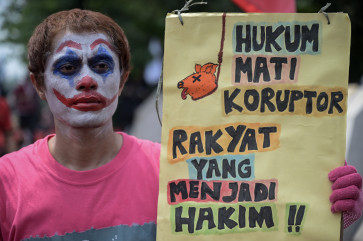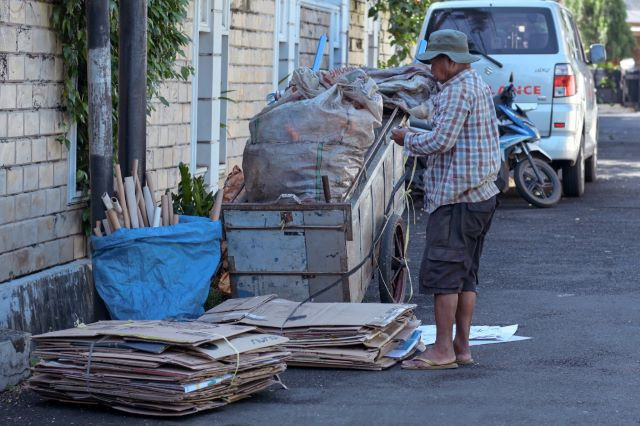Popular Reads
Top Results
Can't find what you're looking for?
View all search resultsPopular Reads
Top Results
Can't find what you're looking for?
View all search resultsGetting to know the ‘Maestro’
Roaring: Raden Saleh is known for his paintings of lions
Change text size
Gift Premium Articles
to Anyone
R
span class="caption" style="width: 467px;">Roaring: Raden Saleh is known for his paintings of lions.Jakartans might be familiar with the name Raden Saleh, but the images appearing in their mind at the mention of the man’s name might not necessarily be that of his masterpieces.
“It’s a street name,” Vina Agita, a Jakartan working near the street she was referring to, said when asked what occurred to her at the mention of “Raden Saleh.”.
There may be good reasons for the failure to associate the name with the works of the Java-born artist often recognized as the forerunner of modernism in Indonesian art. Apart from brief encounters perhaps in school, Saleh’s works are rarely present in the everyday lives of city people nowadays.
Yet there are many reasons to regard the man known as the Maestro with importance. Saleh’s talent was recognized in Europe as well as his homeland, his colorful life story making for fascinating analysis, and even his unique fashion style can make for interesting conversations.
To say an exclusive exhibition of Saleh’s art is overdue might be an understatement, yet the “Raden Saleh and the Beginning of Modern Indonesian Painting” exhibit held at the National Gallery until June 17 has proven that it is never too late to start.
Organized by the Goethe-Institut Indonesia, the National Gallery and the German Embassy with the help of the German-Indonesian Chamber of Commerce (EKONID) and sponsored by BMW, the admission-free exhibition is the first ever in the world, curator Werner Kraus told The Jakarta Post.
Visitors young and old flooded the opening on June 3. While some chose to enjoy the paintings on their own, many took advantage of the available guides, who not only explained the works of Saleh but also his life story to interested listeners.
Saleh was born in Semarang, Central Java, in 1811 and was raised in a wealthy environment that encouraged education.
He displayed a talent at an early age for producing drawings that stunningly resembled the objects they were based on, and at 8 years old received his first lessons in drawing by Europeans who were in the archipelago at that time.
He left for Europe in 1829 and spent his first few years in Antwerp in Belgium and the Netherlands. According to his biography displayed at the exhibition, Saleh displayed his art for the first time at the National Exhibition in Amsterdam in 1834.
According to curator Kraus, the young artist felt uncomfortable in the Netherlands, perhaps because of his being treated as a person of the colony. Saleh proceeded to travel to other places in Europe, including France.
But it was the Germans that reportedly made him feel more at home, or, in Kraus’ words, “they really liked him”. Because to the people in Germany, not only was he unique as someone from Asia, but was also a talented artist.
“They invited [Raden Saleh] to the highest families, and for the first time, he wrote in his letter, he felt accepted. That’s why he stayed in Germany,” Kraus said.
Saleh learned to speak the language, and was said to write in a letter to a friend that he “had come to Europe as a Javanese but went back to Java as a real German”.
He even left a legacy in the form of a blue mosque in Dresden, built for him by his acquaintance Friedrich Serre.
After over 20 years in Europe, the painter returned to his homeland and was received warmly by his fellow Indonesians. However, he was said to be disturbed by the racial prejudice of colonial times.
Saleh died in 1880 in Bogor after visiting Europe with his wife and adopted child shortly before. According to the exhibition information, he realized nearing his final years that he would not find happiness in Java.
His life story accompanied the guide’s explanations of several of the displayed paintings, and visitors were encouraged to try to somehow decode and explore the emotions and sentiments behind those
paintings.
Thus, they learned the story behind the lions frequently featured in Saleh’s works, the reason why some Dutch officials’ portraits were drawn more roughly than others, and why Saleh’s works often depict what appear to be scenes in the Middle East.
One of the favorites for this decoding is Penangkapan Pangeran Dipanegara (The Capture of Dipanegara). Raden Saleh’s family’s close emotional ties with the Javanese royal made its way into the painting, which allegedly features Saleh himself and the depiction of Dutch peoples’ heads as disproportionately larger than their bodies.
Annisa, a high school student who made use of the guide, said she was not familiar at all with Raden Saleh before.
“We were given an assignment from school to go to the exhibition and make a biography about him,” she said.
Although many students might have been visiting the National Gallery that day for the same reason of a school assignment, they appeared to be enjoying themselves.
“Was Raden Saleh a graphic design major?” a young male visitor joked as he and his friends showed their awe at the examples of precise sketches of everyday objects Saleh made when he was still very young.
Taufiq, an older visitor who came with his young son to the exhibition, said he found the guides to be very helpful.
“These paintings, to a common man like me, don’t speak much. So I found out many things [from the guides], especially about the background [behind the works],” he said.
Several of the guides displayed, at least through their explanations to visitors, rich knowledge of the works and life history of the artists.
Kraus said that the works displayed roughly represent “50 percent of Raden Saleh’s work we know” and 80 percent of Saleh’s work in Indonesia.
Most of the works displayed in the exhibition are those collected by Indonesians, he said.
According to Kraus, the exhibition might have tried to bring more paintings from Europe, but “to tell you the truth, the regulation of export and import of paintings to Indonesia is so confusing … nobody really dared … because we didn’t know, can you take [the paintings] out again?”
He lamented that at least one of the works was degraded a little due to improper restoration processes.
Nevertheless, Kraus said that this was the first time that so many paintings by Raden Saleh were collected in one room.
He emphasized that the exhibition did not accept money from collectors and said that he had rejected some works offered to him to be displayed because he regarded them as not being Raden Saleh originals.
Penangkapan Pangeran Dipanegara (The Capture of Dipanegara)“You cannot fake a Raden Saleh. If you want to … you have to be better than Raden Saleh ... I have seen many paintings but I need only one eye to see that this is a fake Raden Saleh. I have seen no good fakes,” Kraus said.
The authenticity of local paintings recently became a hot topic after allegations of forgeries of local maestros such as Affandi and S. Sudjojono arose among collectors and art enthusiasts.
Kraus said he is responsible for the authenticity of the collection displayed.
“But I am human, so of course nobody can guarantee things like that. But I have … a lot of experience,” the 68-year-old said.
As of June 6, more than 2,500 visitors have visited the exhibition, prompting the organizers to extend the opening hours to 8 p.m. on weekends. Guides are available through reservation.
— Photos courtesy of JERIN
“Raden Saleh and the Beginning of Modern Indonesian Painting”
Until June 17
National Gallery
Jakarta

![Roaring: Raden Saleh is known for his paintings of lions." width="469" height="326"><span class="caption" style="width: 467px;">Roaring: Raden Saleh is known for his paintings of lions.</span></span>Jakartans might be familiar with the name Raden Saleh, but the images appearing in their mind at the mention of the man’s name might not necessarily be that of his masterpieces.<br><br>“It’s a street name,” Vina Agita, a Jakartan working near the street she was referring to, said when asked what occurred to her at the mention of “Raden Saleh.”.<br><br>There may be good reasons for the failure to associate the name with the works of the Java-born artist often recognized as the forerunner of modernism in Indonesian art. Apart from brief encounters perhaps in school, Saleh’s works are rarely present in the everyday lives of city people nowadays.<br><br>Yet there are many reasons to regard the man known as the Maestro with importance. Saleh’s talent was recognized in Europe as well as his homeland, his colorful life story making for fascinating analysis, and even his unique fashion style can make for interesting conversations. <br><br>To say an exclusive exhibition of Saleh’s art is overdue might be an understatement, yet the “Raden Saleh and the Beginning of Modern Indonesian Painting” exhibit held at the National Gallery until June 17 has proven that it is never too late to start.<br><br>Organized by the Goethe-Institut Indonesia, the National Gallery and the German Embassy with the help of the German-Indonesian Chamber of Commerce (EKONID) and sponsored by BMW, the admission-free exhibition is the first ever in the world, curator Werner Kraus told The Jakarta Post. <br><br>Visitors young and old flooded the opening on June 3. While some chose to enjoy the paintings on their own, many took advantage of the available guides, who not only explained the works of Saleh but also his life story to interested listeners. <br><br>Saleh was born in Semarang, Central Java, in 1811 and was raised in a wealthy environment that encouraged education. <br><br>He displayed a talent at an early age for producing drawings that stunningly resembled the objects they were based on, and at 8 years old received his first lessons in drawing by Europeans who were in the archipelago at that time. <br><br>He left for Europe in 1829 and spent his first few years in Antwerp in Belgium and the Netherlands. According to his biography displayed at the exhibition, Saleh displayed his art for the first time at the National Exhibition in Amsterdam in 1834.<br><br>According to curator Kraus, the young artist felt uncomfortable in the Netherlands, perhaps because of his being treated as a person of the colony. Saleh proceeded to travel to other places in Europe, including France.<br><br>But it was the Germans that reportedly made him feel more at home, or, in Kraus’ words, “they really liked him”. Because to the people in Germany, not only was he unique as someone from Asia, but was also a talented artist. <br><br>“They invited [Raden Saleh] to the highest families, and for the first time, he wrote in his letter, he felt accepted. That’s why he stayed in Germany,” Kraus said. <br><br>Saleh learned to speak the language, and was said to write in a letter to a friend that he “had come to Europe as a Javanese but went back to Java as a real German”.<br><br>He even left a legacy in the form of a blue mosque in Dresden, built for him by his acquaintance Friedrich Serre. <br><br>After over 20 years in Europe, the painter returned to his homeland and was received warmly by his fellow Indonesians. However, he was said to be disturbed by the racial prejudice of colonial times.<br><br>Saleh died in 1880 in Bogor after visiting Europe with his wife and adopted child shortly before. According to the exhibition information, he realized nearing his final years that he would not find happiness in Java. <br><br>His life story accompanied the guide’s explanations of several of the displayed paintings, and visitors were encouraged to try to somehow decode and explore the emotions and sentiments behind those <br>paintings. <br><br>Thus, they learned the story behind the lions frequently featured in Saleh’s works, the reason why some Dutch officials’ portraits were drawn more roughly than others, and why Saleh’s works often depict what appear to be scenes in the Middle East. <br><br>One of the favorites for this decoding is Penangkapan Pangeran Dipanegara (The Capture of Dipanegara). Raden Saleh’s family’s close emotional ties with the Javanese royal made its way into the painting, which allegedly features Saleh himself and the depiction of Dutch peoples’ heads as disproportionately larger than their bodies. <br><br>Annisa, a high school student who made use of the guide, said she was not familiar at all with Raden Saleh before. <br><br>“We were given an assignment from school to go to the exhibition and make a biography about him,” she said. <br><br>Although many students might have been visiting the National Gallery that day for the same reason of a school assignment, they appeared to be enjoying themselves. <br><br>“Was Raden Saleh a graphic design major?” a young male visitor joked as he and his friends showed their awe at the examples of precise sketches of everyday objects Saleh made when he was still very young. <br><br>Taufiq, an older visitor who came with his young son to the exhibition, said he found the guides to be very helpful. <br><br>“These paintings, to a common man like me, don’t speak much. So I found out many things [from the guides], especially about the background [behind the works],” he said. <br><br>Several of the guides displayed, at least through their explanations to visitors, rich knowledge of the works and life history of the artists. <br><br>Kraus said that the works displayed roughly represent “50 percent of Raden Saleh’s work we know” and 80 percent of Saleh’s work in Indonesia. <br><br>Most of the works displayed in the exhibition are those collected by Indonesians, he said. <br><br>According to Kraus, the exhibition might have tried to bring more paintings from Europe, but “to tell you the truth, the regulation of export and import of paintings to Indonesia is so confusing … nobody really dared … because we didn’t know, can you take [the paintings] out again?” <br><br>He lamented that at least one of the works was degraded a little due to improper restoration processes.<br><br>Nevertheless, Kraus said that this was the first time that so many paintings by Raden Saleh were collected in one room. <br><br>He emphasized that the exhibition did not accept money from collectors and said that he had rejected some works offered to him to be displayed because he regarded them as not being Raden Saleh originals.<br><br><span class="inline inline-right"><img class="image image-img_assist_custom-469x319 " src="http://www.thejakartapost.com/files/images2/up p21-a_357.img_assist_custom-469x319.jpg" border="0" alt="Penangkapan Pangeran Dipanegara (The Capture of Dipanegara)" title="Penangkapan Pangeran Dipanegara (The Capture of Dipanegara)](https://www.thejakartapost.com/files/images2/up p21-b_283.img_assist_custom-470x326.jpg)









